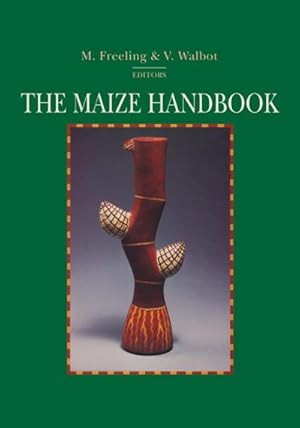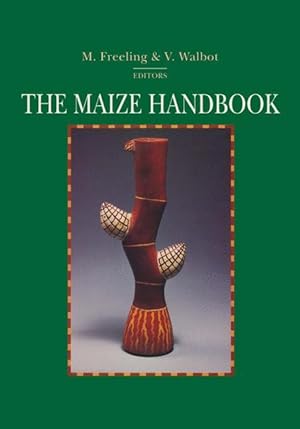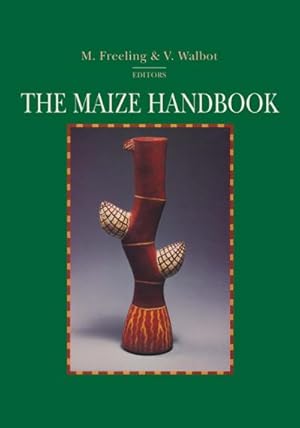Maize Handbook by Freeling Michael (11 results)
FeedbackSearch filters
Product Type
- All Product Types
- Books (11)
- Magazines & Periodicals (No further results match this refinement)
- Comics (No further results match this refinement)
- Sheet Music (No further results match this refinement)
- Art, Prints & Posters (No further results match this refinement)
- Photographs (No further results match this refinement)
- Maps (No further results match this refinement)
- Manuscripts & Paper Collectibles (No further results match this refinement)
Condition Learn more
- New (7)
- As New, Fine or Near Fine (No further results match this refinement)
- Very Good or Good (4)
- Fair or Poor (No further results match this refinement)
- As Described (No further results match this refinement)
Binding
Collectible Attributes
- First Edition (No further results match this refinement)
- Signed (No further results match this refinement)
- Dust Jacket (No further results match this refinement)
- Seller-Supplied Images (4)
- Not Print on Demand (9)
Language (1)
Free Shipping
Seller Location
Seller Rating
-
US$ 11.01
Convert currencyUS$ 10.63 shipping from United Kingdom to U.S.A.Quantity: 1 available
Add to basketCondition: Very Good. Ships from the UK. Former library book; may include library markings. Used book that is in excellent condition. May show signs of wear or have minor defects.
-
paperback. Condition: Good. Connecting readers with great books since 1972! Used textbooks may not include companion materials such as access codes, etc. May have some wear or writing/highlighting. We ship orders daily and Customer Service is our top priority!
-
The Maize Handbook (Springer Lab Manuals)
Seller: The Book House, Inc. - St. Louis, St. Louis, MO, U.S.A.
Hard Cover. Condition: Very Good. Dust Jacket Condition: No Dust Cover. Very good hard cover. No dust jacket. Previous owner's name written inside.
-
US$ 134.16
Convert currencyUS$ 33.23 shipping from United Kingdom to U.S.A.Quantity: 1 available
Add to baskethardcover. Condition: Good. Good. book.
-
The Maize Handbook (Springer Lab Manuals)
Seller: Ria Christie Collections, Uxbridge, United Kingdom
US$ 183.61
Convert currencyUS$ 15.92 shipping from United Kingdom to U.S.A.Quantity: Over 20 available
Add to basketCondition: New. In.
-
Condition: New.
-
The Maize Handbook
Published by Springer New York, Springer US, 1996
ISBN 10: 0387947353 ISBN 13: 9780387947358
Language: English
Seller: AHA-BUCH GmbH, Einbeck, Germany
US$ 198.61
Convert currencyUS$ 40.20 shipping from Germany to U.S.A.Quantity: 1 available
Add to basketTaschenbuch. Condition: Neu. Druck auf Anfrage Neuware - Printed after ordering - The Maize Handbook represents the collective efforts of the maize research community to enumerate the key steps of standard procedures and to disseminate these protocols for the common good. Although the material in this volume is drawn from experience with maize, many of the procedures, protocols, and descriptions are applicable to other higher plants, particularly to other grasses. The power and resolution of experiments with maize depend on the wide range of specialized genetic techniques and marked stocks; these materials are available today as the culmination of nearly 100 years of genetic research. A major goal of this volume is to introduce this genetical legacy and to highlight current stock construction programs that will soon benefit our work, e. g. high-density RFLP maps, deletion stocks, etc. Both stock construction and maintenance are relatively straightforward in maize as a result of the ease of crossing and the longevity of stored seeds. Crossing is facilitated by the separate staminate (tassel) and pistillate (ear) flowers, a feature almost unique to maize. On the other hand, many of the genetic methodologies utilized with maize, including the precision of record keeping, can be adapted to other plants. Facile communication and a spirit of co-operation have characterized the maize genetics community since its earliest days. Starting in the 1930s, institutions such as annual Maize Genetics Cooperation Newsletter, the Maize Genetics Stock Center, and the annual maize genetics meeting provide continuity to the field.
-
The Maize Handbook
Published by Springer New York, Springer US Jun 1996, 1996
ISBN 10: 0387947353 ISBN 13: 9780387947358
Language: English
Seller: buchversandmimpf2000, Emtmannsberg, BAYE, Germany
US$ 191.54
Convert currencyUS$ 63.73 shipping from Germany to U.S.A.Quantity: 2 available
Add to basketTaschenbuch. Condition: Neu. Neuware -The Maize Handbook represents the collective efforts of the maize research community to enumerate the key steps of standard procedures and to disseminate these protocols for the common good. Although the material in this volume is drawn from experience with maize, many of the procedures, protocols, and descriptions are applicable to other higher plants, particularly to other grasses. The power and resolution of experiments with maize depend on the wide range of specialized genetic techniques and marked stocks; these materials are available today as the culmination of nearly 100 years of genetic research. A major goal of this volume is to introduce this genetical legacy and to highlight current stock construction programs that will soon benefit our work, e. g. high-density RFLP maps, deletion stocks, etc. Both stock construction and maintenance are relatively straightforward in maize as a result of the ease of crossing and the longevity of stored seeds. Crossing is facilitated by the separate staminate (tassel) and pistillate (ear) flowers, a feature almost unique to maize. On the other hand, many of the genetic methodologies utilized with maize, including the precision of record keeping, can be adapted to other plants. Facile communication and a spirit of co-operation have characterized the maize genetics community since its earliest days. Starting in the 1930s, institutions such as annual Maize Genetics Cooperation Newsletter, the Maize Genetics Stock Center, and the annual maize genetics meeting provide continuity to the field.Springer Verlag GmbH, Tiergartenstr. 17, 69121 Heidelberg 792 pp. Englisch.
-
US$ 282.88
Convert currencyUS$ 13.29 shipping from United Kingdom to U.S.A.Quantity: 2 available
Add to basketPaperback. Condition: Brand New. 792 pages. 9.50x7.25x1.75 inches. In Stock.
-
The Maize Handbook
Seller: moluna, Greven, Germany
US$ 158.43
Convert currencyUS$ 56.77 shipping from Germany to U.S.A.Quantity: Over 20 available
Add to basketCondition: New. Dieser Artikel ist ein Print on Demand Artikel und wird nach Ihrer Bestellung fuer Sie gedruckt. The Maize Handbook represents the collective efforts of the maize research community to enumerate the key steps of standard procedures and to disseminate these protocols for the common good. Although the material in this volume is drawn from experience with.
-
The Maize Handbook
Published by Springer New York Jun 1996, 1996
ISBN 10: 0387947353 ISBN 13: 9780387947358
Language: English
Seller: BuchWeltWeit Ludwig Meier e.K., Bergisch Gladbach, Germany
US$ 191.54
Convert currencyUS$ 26.65 shipping from Germany to U.S.A.Quantity: 2 available
Add to basketTaschenbuch. Condition: Neu. This item is printed on demand - it takes 3-4 days longer - Neuware -The Maize Handbook represents the collective efforts of the maize research community to enumerate the key steps of standard procedures and to disseminate these protocols for the common good. Although the material in this volume is drawn from experience with maize, many of the procedures, protocols, and descriptions are applicable to other higher plants, particularly to other grasses. The power and resolution of experiments with maize depend on the wide range of specialized genetic techniques and marked stocks; these materials are available today as the culmination of nearly 100 years of genetic research. A major goal of this volume is to introduce this genetical legacy and to highlight current stock construction programs that will soon benefit our work, e. g. high-density RFLP maps, deletion stocks, etc. Both stock construction and maintenance are relatively straightforward in maize as a result of the ease of crossing and the longevity of stored seeds. Crossing is facilitated by the separate staminate (tassel) and pistillate (ear) flowers, a feature almost unique to maize. On the other hand, many of the genetic methodologies utilized with maize, including the precision of record keeping, can be adapted to other plants. Facile communication and a spirit of co-operation have characterized the maize genetics community since its earliest days. Starting in the 1930s, institutions such as annual Maize Genetics Cooperation Newsletter, the Maize Genetics Stock Center, and the annual maize genetics meeting provide continuity to the field. 792 pp. Englisch.







